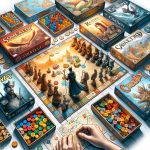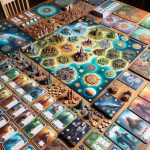The historical significance of World War 1 (WW1) is undeniable, shaping the course of the 20th century and leaving a lasting impact on global history. In recent years, strategy board games set during this era have gained popularity, offering players a chance to immerse themselves in the tactical and strategic challenges faced by leaders during WW1.
These games provide a unique and engaging way to explore the complexities of this pivotal time in history, while also honing critical thinking and decision-making skills. This article will delve into the world of WW1 strategy board games, examining their historical accuracy, gameplay mechanics, community involvement, educational value, and looking towards the future of this genre.
As we explore the influence of WW1 on strategy board games and delve into some popular titles set in this historical period, it is important to understand how the real-life events of WW1 have shaped these game experiences. From battles on the Western Front to naval warfare and technological advancements, every aspect of WW1 has contributed to the development of strategy board games that aim to capture its essence.
The themes and elements central to this conflict have been incorporated into these games’ narratives and gameplay mechanics, allowing players to strategize as commanders did during this tumultuous time.
Furthermore, we will take an in-depth look at how game designers ensure historical accuracy in these strategy board games set in WW1. The level of dedication to capturing authentic details from this era contributes not only to gameplay realism but also serves as an educational tool for players interested in understanding more about significant events and decision-making processes during WW1.
The strategic and tactical elements present within these board games mirror those faced by military leaders during this time, requiring players to adapt their strategies accordingly. Throughout this article, we will examine how playing these games can provide insight into historical events while challenging individuals with immersive gameplay experiences.
The Impact of WW1 on Strategy Board Games
The impact of World War 1 (WW1) on strategy board games was significant, as the historical events and tactics of this war heavily influenced the development of these games. WW1, also known as the Great War, saw unprecedented levels of conflict and introduced new military strategies and technology that have since been incorporated into strategy board games.
This period in history has inspired game designers to create interactive experiences that allow players to immerse themselves in the challenges faced by military leaders during WW1.
Key Themes and Elements from WW1 were incorporated into strategy board games such as:
- Trench Warfare: The static nature of trench warfare and the need for careful planning under constant threat strongly influenced board game mechanics.
- Technological Advancements: The introduction of tanks, aircraft, and chemical warfare in WW1 led to innovations in tactics and strategy that are reflected in board game designs.
- Global Conflict: The scale of WW1 spanning multiple continents and involving various alliances has provided a rich backdrop for strategic gameplay.
The ability of strategy board games to capture and recreate the complexities of war during WW1 has made them popular among history enthusiasts, war gamers, and those looking for challenging gameplay experiences. Game designers continue to draw inspiration from this pivotal period in history, ensuring that these games remain relevant and engaging for years to come.
Popular Strategy Board Games Set in WW1
The historical significance of World War 1 has captured the interest of many, including game designers who have created a variety of strategy board games set during this time period. These games provide players with the opportunity to immerse themselves in the strategic and tactical challenges faced by leaders during the war. From recreating historic battles to simulating the decision-making process of military leaders, these games offer a unique way to engage with history.
One example of a popular strategy board game set in WW1 is “Memoir ’44.” This game allows players to relive the key battles of the war through a series of campaigns and scenarios. With historically accurate miniatures and terrain tiles, “Memoir ’44” provides an immersive experience that captures the essence of combat during WW1. The game’s mechanics also emphasize strategic planning and adaptability, reflecting the challenges faced by military commanders during the war.
Another well-known WW1 strategy board game is “Paths of Glory,” which focuses on the broader scope of the conflict by allowing players to take on the roles of rival powers vying for control over Europe. This game delves into diplomatic negotiations, military operations, and political strategies, providing a comprehensive overview of the complex dynamics at play during WW1.
Additionally, “The Great War” offers players a chance to experience trench warfare and maneuvering across different battlefields. With its focus on unit positioning and resource management, this game captures the gritty reality of trench warfare during WW1. These are just a few examples among many that highlight how strategy board games set in WW1 allow players to engage with history while honing their tactical skills.
Historical Accuracy in Strategy Board Games
The historical accuracy in strategy board games set during WW1 is a crucial aspect that adds depth and realism to the gameplay experience. Game designers strive to incorporate accurate historical details into these games, providing players with an opportunity to immerse themselves in the events and settings of the time period. By doing so, players can gain a better understanding of the strategies, tactics, and decision-making involved in WW1.
Key elements of historical accuracy found in WW1 strategy board games include the representation of real battles, the use of authentic weaponry and equipment, and the inclusion of historical figures or leaders. Designers meticulously research the historical context to ensure that the game reflects the realities of warfare during WW1. This attention to detail not only enhances the overall gaming experience but also serves as an educational tool for players.
Incorporating historical accuracy into strategy board games set in WW1 requires a delicate balance between authenticity and playability. While designers aim to stay true to historical details, they must also consider the need for engaging gameplay mechanics and balanced strategies for all players. This challenge often leads to innovative game design solutions that effectively capture the essence of WW1 while providing an enjoyable gaming experience for all.
- Examples:
- “Risk: Europe 1914″
- “Command & Colors: The Great War”
- “Fields of Despair: France 1914-1918″
Strategy and Tactics in WW1 Board Games
During World War 1, military tactics and strategies played a crucial role in the outcome of battles. This significant historical event has greatly influenced the development of strategy board games, as game designers often incorporate key tactical and strategic elements from WW1 into their gameplay. In strategy board games set in this era, players are required to utilize real-life military tactics and make strategic decisions similar to those faced by commanders during the war.
One of the key elements present in WW1 strategy board games is trench warfare. This type of warfare was a defining feature of World War 1, characterized by entrenched soldiers engaging in prolonged battles across fortified positions. Games such as “The Grizzled” and “Fields of Despair” replicate this aspect of WW1 by requiring players to navigate the challenges posed by trench warfare, including limited mobility, complex supply lines, and the constant threat of enemy attacks.
Additionally, strategy and tactics in WW1 board games often involve resource management and troop deployment. Players must carefully allocate resources such as manpower, ammunition, and supplies while making decisions about deploying troops to various fronts.
Games like “1914: Glory’s End/When Eagles Fight” and “Paths of Glory” require players to formulate effective strategies for managing limited resources and positioning troops strategically on the battlefield. These elements not only capture the historical context of WW1 but also provide players with a deeper understanding of the challenges faced by military commanders during that time.
Lastly, some board games set in WW1 focus on naval and aerial warfare, introducing players to the strategic complexities of these aspects of combat during the war. Titles such as “Dreadnoughts” and “Wings of Glory” simulate naval battles and aerial dogfights, allowing players to experience firsthand the strategic decision-making required in these critical areas of warfare during World War 1.
| Key Elements | Strategy Board Games |
|---|---|
| Trench Warfare | “The Grizzled”, “Fields of Despair” |
| Resource Management | “1914: Glory’s End/When Eagles Fight”, “Paths of Glory” |
| Naval & Aerial Warfare | “Dreadnoughts”, “Wings of Glory” |
Community and Competitive Aspects of WW1 Board Games
When it comes to strategy board games set in World War 1, the community and competitive aspects play a significant role in the overall experience for players. The popularity of these games has led to the development of a dedicated community that actively engages in tournaments, events, and online platforms to connect with fellow enthusiasts.
Tournaments and events centered around WW1 strategy board games provide an opportunity for players to showcase their skills and strategic prowess. These gatherings often attract a diverse group of individuals who share a common passion for history and gaming. It also serves as a platform for players to learn from each other, exchange tactics, and form connections within the community.
In addition to physical gatherings, there is a thriving online community dedicated to WW1 strategy board games. Various forums, social media groups, and online platforms cater to players looking to discuss game strategies, share historical insights, and organize digital competitions. The accessibility of these online communities allows players from around the world to engage with like-minded individuals, fostering a sense of camaraderie despite geographical barriers.
Ultimately, the community and competitive aspects of WW1 board games contribute significantly to the overall experience for players. Whether participating in local tournaments or connecting with fellow enthusiasts online, these games have succeeded in creating a passionate community that continues to grow and thrive.
| Aspect | Description |
|---|---|
| Tournaments & Events | Physical gatherings where players can showcase their skills and connect with others. |
| Online Community | Dedicated forums and platforms for discussing strategies and organizing digital competitions. |
Educational Value of WW1 Strategy Board Games
Strategy board games set in World War 1 offer not only entertainment but also educational value, providing players with a unique opportunity to learn about the historical events, decisions, and strategies that shaped the course of the war. These games can serve as a valuable tool for understanding the complexities of WW1, allowing players to immerse themselves in the challenges faced by military leaders and decision-makers during this pivotal period in history.
Insight Into Historical Events
One of the most significant educational benefits of WW1 strategy board games is their ability to provide insight into the historical events and context of the war. Players have the opportunity to engage with accurate representations of battles, conflicts, and geopolitical dynamics that defined WW1. By reenacting these historical events through gameplay, players can gain a deeper understanding of the challenges and decisions faced by military leaders during the war.
Strategic Thinking and Decision-Making
Another key educational aspect of WW1 strategy board games is their emphasis on strategic thinking and decision-making. Players are required to develop and execute tactical plans, manage resources, and make critical decisions in order to achieve their objectives. This process mirrors the real-life challenges faced by military commanders during WW1, allowing players to experience firsthand the complexities of wartime strategy.
Critical Analysis and Problem-Solving
Furthermore, playing strategy board games set in World War 1 can promote critical analysis and problem-solving skills. Players must assess historical scenarios, evaluate potential courses of action, and adapt their strategies based on changing circumstances – all essential skills that can be applied beyond the gaming table. By engaging with these games, players can develop a deeper appreciation for historical context while honing their analytical and decision-making abilities.
The Future of WW1 Strategy Board Games
As the popularity of strategy board games set in World War 1 continues to grow, the future of these games looks promising. Game designers and developers are constantly exploring new ways to innovate and improve the gameplay experience, drawing inspiration from historical events and incorporating advancements in game design.
With the ongoing interest in historical warfare and strategy games, it’s likely that we will see a steady stream of new releases and expansions for WW1 strategy board games in the coming years.
One potential trend for the future of WW1 strategy board games is the integration of digital components. While traditional board games have their appeal, incorporating digital elements can enhance gameplay by providing interactive features, historical context, and immersive experiences. This combination of physical and digital gaming could open up new opportunities for storytelling, strategy development, and community engagement within the WW1 gaming community.
Another aspect to consider is the potential for advancements in game mechanics inspired by WW1. Game designers may continue to explore innovative ways to simulate historical battles, tactics, and decision-making processes within their games. By staying true to historical accuracy while also incorporating engaging gameplay mechanics, future WW1 strategy board games have the potential to offer players a more immersive and educational experience.
Overall, it’s clear that WW1 strategy board games will continue to be an important part of the gaming industry. Whether through advancements in technology, innovative game design, or a growing community of players, these games are poised for continued success in offering both entertainment and educational value for those interested in historical warfare and strategic gameplay.
With new releases on the horizon and a dedicated fan base, there’s much to look forward to in the evolving world of WW1 strategy board games.
Conclusion
In conclusion, strategy board games set in WW1 have proven to be influential and popular forms of entertainment that offer both historical insight and engaging gameplay. The impact of WW1 on these games is apparent through the incorporation of key themes and elements from the war, providing players with an immersive experience that educates as well as entertains.
The historical accuracy and attention to detail in these games make them valuable tools for learning about the events and decision-making processes of WW1.
As the community and competitive scene for WW1 strategy board games continues to thrive, it is evident that these games have a lasting appeal for enthusiasts and history buffs alike. Tournaments, events, and online communities dedicated to these games provide platforms for players to engage with like-minded individuals while honing their strategic skills.
Additionally, the educational value of these games cannot be understated, as they offer a unique way for players to gain insight into historical events and warfare tactics.
Looking towards the future, it is likely that we will see continued advancements in game design and mechanics inspired by WW1. As new releases emerge and trends develop within the gaming industry, it is important to recognize the ongoing significance of WW1 strategy board games. Encouraging readers to explore and experience these games for themselves can lead to a greater appreciation for history and an enjoyable way to engage with strategic gameplay.
Frequently Asked Questions
What Board Games Did Soldiers Play in WW1?
In World War 1, soldiers played board games such as Chess, Checkers, and Backgammon during their downtime. These games provided a mental escape from the harsh realities of war and helped pass the time.
What Is the Most Famous Strategy Board Game?
The most famous strategy board game is undoubtedly Chess. With origins dating back to the 6th century, Chess is a game of skill, strategy, and foresight that has captured the interest of players around the world for centuries.
Are There Any Good WW1 RTS Games?
There are several good World War 1 real-time strategy (RTS) games available for those interested in this historical period. Games like “Valiant Hearts: The Great War” and “Verdun” offer immersive gameplay experiences set during WW1, allowing players to engage with strategic elements from this era.

I love playing all kinds of games – from classics like Monopoly to modern favourites like Ticket to Ride.
I created this blog as a way to share my love of board games with others, and provide information on the latest releases and news in the industry.





